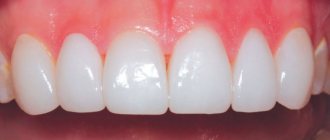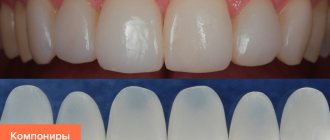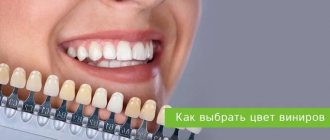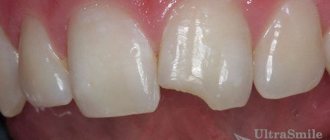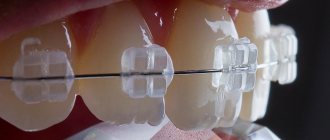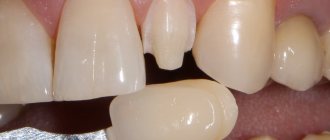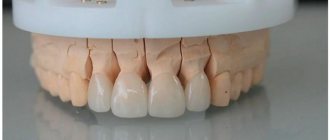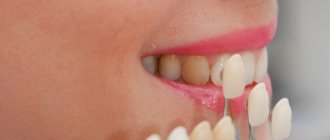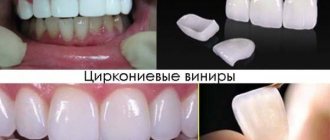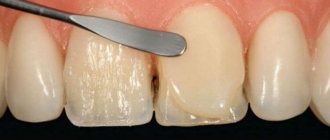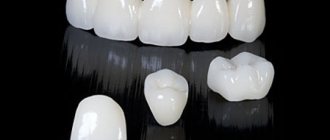Types of ceramic veneers
The classification of veneers is related to their manufacturing technologies.
Pressed veneers are made from dental porcelain. As a result, an ultra-thin plate is created, which is subsequently ground and glazed, which creates a pleasant natural shine. A similar technique is used to create ultra-thin E-max ceramic veneers.
Zirconium veneers are a separate type of ceramic veneers that are made from zirconium dioxide. The basis of the two-layer structure is a zirconium plate. A ceramic layer is applied to it. The zirconium frame provides extra strength.
Other benefits include:
• the shade does not change over time; • thickness of only 0.3 mm ensures invisibility; • does not cause allergies; • service life 20 years.
Not everyone can afford the price. This is the drawback.
A popular service at our clinic is the installation of feldspathic veneers. During their manufacture, the technician applies ceramics layer by layer, which is a precise, highly artistic work. The ceramic layers are no more than a fraction of a millimeter. During the specialist’s work, anthropometric data are taken into account. With their help, it is possible to present the overall picture of the dentition, the smile line, and plan the ideal shape of the structure. As a result, feldspathic veneers cannot be distinguished from natural teeth. .
Installation of temporary veneers
Temporary veneers are installed directly after tooth preparation. For installation, standard equipment and a silicone template are used. After polymerization, the structures are not removed; correction and polishing are done in the oral cavity. The veneers are adjusted so that diction is not distorted and conversation is comfortable. The shade is not specially selected; a neutral option is used. Aesthetics in this case does not come first. Reliability is more important.
The fixation of temporary overlays is not durable, so that there are no problems when removing them. Perhaps this design will come off. To restore the fixation, you should contact your dentist. The repeated procedure will take no more than twenty minutes. If the patient has an allergy, the doctor must be informed about this. Plastic can be replaced with a special composite mass.
Manufacturing and installation
Ceramic veneers are installed after successive stages of work by a doctor at the ROCOSCLINIC clinic.
1. Consultation - a specialist finds out what aesthetic problems concern the client. The bite, defects, and enamel shade are taken into account. 2. The technician performs virtual modeling of teeth using a computer program. With the help of simple manipulations, thanks to mock-up technology, the formed volume of teeth helps to create temporary plastic structures. 3. Fitting, approval of the shape and color of the crown of the teeth. 4. Fixation of permanent ceramic restorations using a microscope ensures high precision.
Products are manufactured in our dental laboratory.
Tooth color determination
Color selection must be carried out according to the recommendations given in the relevant section.
It is preferable to do this at the beginning of the visit, since it is possible to focus on the color of the tooth that has not yet been prepared (if the color has not changed) and the tooth is naturally moisturized. When drying from prolonged opening of the mouth, especially when using a rubber dam, the teeth become lighter and more dull, which can lead to errors in color selection. It is important to determine the color of the tooth based on the shade that the dental technician will work with (in the case of laboratory production). No translation from one colorway to another (for example, from Vitapan to Chromascop) is accurate, because each colorway has unique, non-repeating colors.
How is a ceramic veneer different from a lumineer?
Ceramic veneers and lumineers are not the same thing. Lumineers are also dental coverings, only:
• veneers are thicker, so you have to grind off the enamel layer before installing them. In addition, at the junction of the gum and the attachment of the plate, after a while a small space may form where food debris will accumulate; • the warranty period for veneers is shorter; • veneers are cheaper than lumineers.
Lumineers have recently appeared. People often call them “Hollywood”, as they help create the snow-white smile of celebrities.
Veneers and dental treatment
Is it necessary to treat caries before installing veneers? Many doctors install veneers on composite filling materials, but this material shrinks by several percent of its volume after just a few years. Consequently, the veneer may no longer be fixed so reliably. In addition, the number of layers of material in the case of “tooth + filling + veneer” is three, which is a lot. Conclusion:
the fewer layers, the higher the reliability of fastening the structure, therefore the ideal scheme for installing veneers is: only the tooth and only the veneer. No problem, if suddenly the patient asks “what if the filling needs to be removed and there is a depression in the tooth?”, my answer is absolutely nothing to worry about, the veneer will simply have additional volume in this place to fill the defect, and the patient will get it you will get only the tooth and only the veneer, without any shrinkage in the future and with one layer of attachment of the veneer to the tooth.
Is it possible to install a veneer if a tooth is damaged?
It is not necessary to have a healthy tooth to install a veneer. We need, at a minimum, only a healthy root, and the veneer will play the role of the missing module for the tooth; it will look like a monolithic crown with the root part: only the tooth and only the missing veneer module. Repeating the conclusions of the previous paragraph - 2 components, no more, this is the main rule.
Caring for ceramic veneers
After ceramic veneers have been installed, you should not forget about the features of oral care.
1. It is necessary to avoid severe mechanical stress and consumption of solid food. All this can lead to damage to the product; 2. You cannot eat cold and hot foods at the same time. Alternating contrasting temperature conditions can cause the ceramic veneer to crack. 3. There is no need to use pastes containing abrasive substances, otherwise the ceramics are subject to microcracks. It is in them that coloring substances accumulate, which over time spoil the appearance of the veneers. 4. You should pay attention to your toothbrush. Her bristles should be soft. To treat the surface of teeth not covered with veneers, you can use a brush with medium hardness. Vibrating brushes can promote peeling of records, so the choice should be in favor of simple ones. 5. It is necessary to include the use of an irrigator into a healthy habit. A stream of water removes food between the teeth where the brush did not reach; micromassage exerts pressure on the gums. All this has a beneficial effect on gum health.
It makes sense to regularly visit the dentist of the ROCOSCLINIC clinic in order to promptly eliminate problems and carry out professional hygiene.
Despite the strength of the structure, it is necessary to adhere to these recommendations. Ceramic veneers will last longer and look better if you take proper care of your mouth.
How veneers are fixed
How the veneers are bonded depends on what they are made of. If the veneers are composite , then the process of attaching them to the tooth is more like installing a filling. And if thin aesthetic plates-onlays (eluminers) are made of ceramics, glass-ceramics or zirconium oxide, then their fixation will be more difficult. Both the tooth surface and the veneers themselves will require special treatment.
How to prepare a tooth
First of all, the tooth is prepared (in other words, ground), giving it a geometrically correct and even shape for better fit with the veneer. Then an impression is taken from such a tooth, from which a veneer is made. This takes 10-14 days, during which the ground tooth is covered with a so-called temporary veneer - a special plastic overlay. When the permanent veneers are ready, you can begin to fix them. To do this, the temporary veneer is removed from the tooth, and all traces of the material holding it in place are carefully removed. This is done using a sandblasting machine and special brushes. Then acid etching of the tooth surface is carried out, making it porous and sensitive to the penetration of desired substances. The final stage of tooth processing is priming and applying an adhesive (that is, bonding) material.
How to prepare a veneer
Processing a veneer is somewhat similar to preparing a tooth: the part that will come into contact with the tooth is also treated with acid to create a rough surface. Typically, hydrofluoric acid is used, which dissolves the silica from the porcelain veneer material. This creates myropores into which the fixing substance can penetrate. Another assistant to reliable gluing is a silane agent (hydrogen silicon): it is applied for 60 seconds and promotes uniform distribution of the adhesive over the entire surface of the veneer. Now you can connect the veneer and tooth using a special dental composition!
How to fix the veneer
Fixing materials are called composites or dental cements, and today their variety is quite large. This composition is applied to the inner surface of the veneer, after which it is pressed tightly against the tooth. Excess material protruding beyond the surface of the veneer is removed. The thin plate is very quickly firmly fixed on the tooth, after which the final grinding and polishing of its surface is performed. That's all: for the next twenty years you won't have to worry about the beauty of your teeth - it will be flawless!
Expert opinion
Fixing veneers is a rather labor-intensive process. And it is how well it is done that determines how securely the veneers will stay on the teeth. And this is one of the main indicators of their quality - after all, every patient can make their teeth straight and white once and for all, and, if possible, never return to this issue.
Therefore, first of all, you need to choose a truly knowledgeable doctor - an experienced orthodontist who will fix the veneers. If you are confident in his professionalism, then you will not have to think about, for example, which fixing composition from the many existing ones should be used.
A good doctor will accurately choose the most appropriate one for a particular situation. It is only important that he has the opportunity to choose from several options. Therefore, you need to contact only large, serious, well-established and well-equipped dental clinics.
Where is the ROCOSCLINIC clinic located?
Moscow is a city where you can get any dental service, one of which includes the installation of ceramic veneers. Call us, sign up for a consultation and we will be happy to consider your problem related to the aesthetic unattractiveness of your teeth.
The task of doctors is not only to treat, but also to restore the beauty of a smile. And it works out well. See for yourself. We know how to make your smile radiant and charming.
We are waiting for you at the address: Moscow, 17-Maryina Roshchi pr-d, no. 1.
What problems do temporary veneers solve?
Temporary veneers are needed:
- To protect the enamel;
- Perform a corrective function;
- Cover the treated (ground) surface of the tooth, gray and rough;
- Eliminate increased sensitivity to cold and hot foods associated with grinding teeth (unpleasant sensations will completely disappear after installing permanent veneers);
- Get used to the overlays;
- “Try on” a beautiful smile.
In the latter case, temporary veneers are a test: if the patient is satisfied with everything, you can install permanent structures, but if not, the patient will not waste his money.
During a follow-up visit to the doctor, temporary veneers are replaced with permanent ones.
Working impression and occlusion determination
When making a veneer in a laboratory in a clinic, it is necessary to take an impression from the dentition, including the prepared tooth, an auxiliary impression from the antagonist dentition, and determine the patient’s usual occlusion.
Precision polyvinylsiloxane (silicon-A) materials are best suited for the working impression. For preparations with a shoulder at or below the gingival level, gingival retraction is performed and a two-layer impression is obtained using a one-step or two-step technique, depending on preference.
For an auxiliary impression, alginate mass is used. And to register occlusion, special silicones are used again. The advantage of these special materials over waxes is that they are more rigid and allow the application of registration material after closure of the dentition and control of occlusion. The base layer of the impression mass, as well as the base wax, are not suitable for recording occlusion, since they are not rigid enough and can lead to significant errors.
Preprint
A preliminary impression is necessary to make a temporary veneer.
If the shape of the tooth is intact or slightly changed, then this impression can be used for the clinical fabrication of a temporary restoration, and then it is enough to take it with a partial tray.
If a laboratory is involved in making a temporary veneer, it is necessary to take an impression from the entire dentition, as well as a second impression from the antagonist dentition.
For preliminary impressions, alginate masses are most often used, since they allow better brightening of the cervical area in one step or more, and are economical.
During storage, the alginate impression must be placed in a tightly closed plastic bag without adding anything to it. Such storage is preferable to storage in water, since it will prevent the impression not only from excessive shrinkage, but also from the occurrence of porosity as a result of leaching of mass particles. It is worth noting that impressions made from modern alginate materials, when properly stored, do not shrink within 100 hours.
